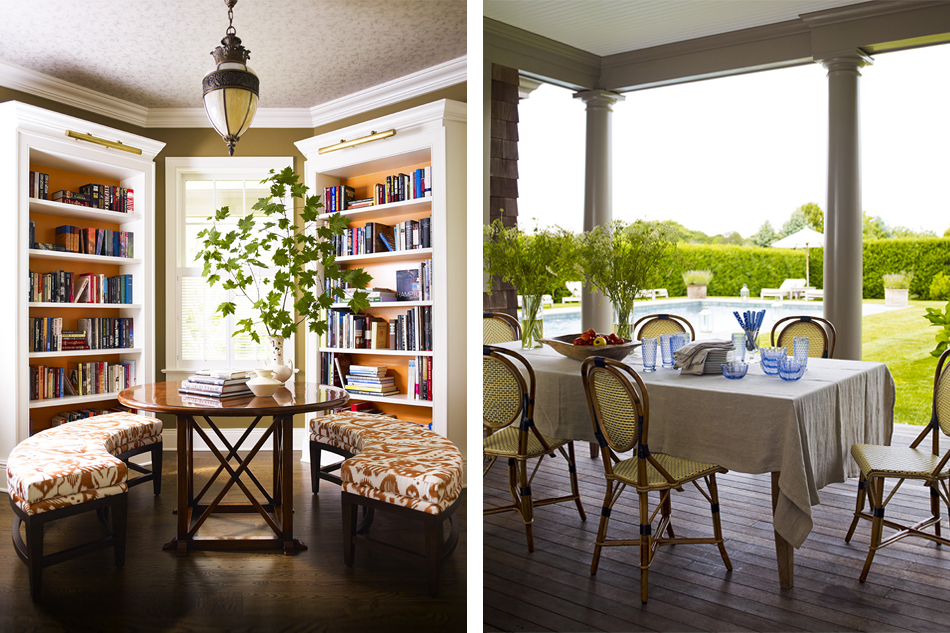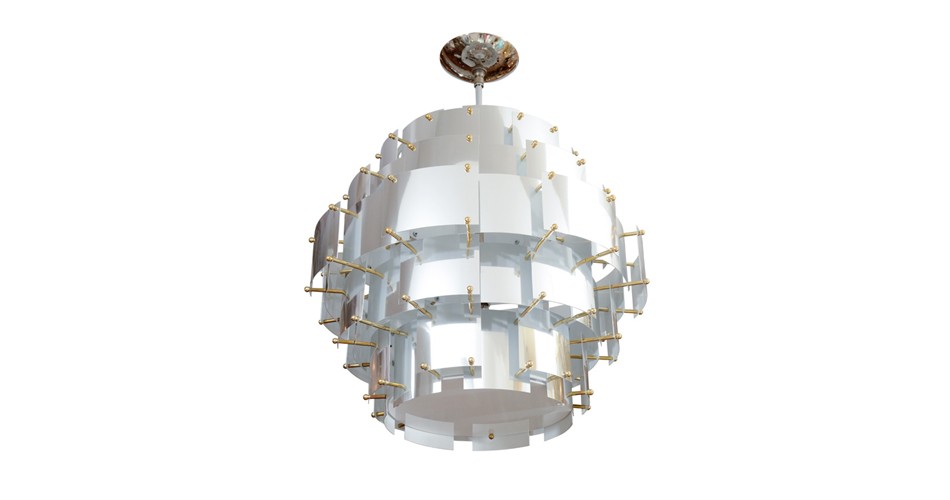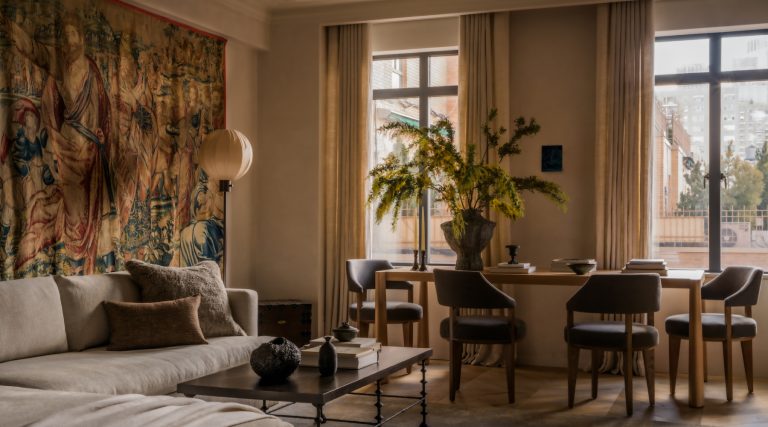
July 23, 2014Gideon Mendelson studied at Columbia University and the New York School of Interior Design before founding his firm in 2003. Top: The designer’s room at the 2013 Westchester Showhouse features a 1958 Max Ingrand chandelier by Fontana Arte from Bernd Goeckler Antiques hanging above a 1950s Edward Wormley Tête-à-Tête sofa from Mark Frisman. All photos by Eric Piasecki
The 19th-century artist James McNeill Whistler’s brief foray into interior design exemplifies the kind of snobbery one often associates with the profession. Originally commissioned by shipping magnate Frederick Leyland to create murals for the now-celebrated Peacock Room of his London townhouse, Whistler went much further, changing the room’s entire color scheme, cornices and wainscoting, which enraged his client and spawned both acrimony and a lawsuit. “Ah, I have made you famous,” Whistler reportedly said to Leyland about what he considered his improvements. “My work will live when you are forgotten.”
The modern-day New York designer Gideon Mendelson, on the other hand, might be what you call the anti-Whistler.
“There’s a stereotyped personality in our business that I just don’t do,” says the 40-year-old designer, referring to the image of the decorator as an arrogant arbiter of taste. Most of his clients — especially a core group he describes as “young financial people in their thirties and forties,” who have been with him since he established his own firm, Mendelson Group, in 2003 — come to him precisely for his down-to-earth personality and his organized, clear-headed approach to his work. Putting clients at ease by letting them know exactly what to expect and when, he builds camaraderie. “They see I’m much like them,” he says. “I have a family, and I work so I can support my family, just like them.”

For his showstopping room at the Kips Bay Decorator Show House this year, Mendelson used a backdrop of deep teal to set off a pair of Giò Ponti club chairs, 1938, from Sebastian + Barquet; an Hervé van der Straeten mirror, 2011, from Maison Gerard; and a 1960s Italian cantilevered brass pendant from John Salibello.
Clearly, they also appreciate Mendelson’s aesthetic, not least of all his confident approach to color, which is among the first things one notices upon entering one of his interiors. For example, in the recent Kips Bay Decorator Show House, he washed his “Lady’s Lair” in a deeply saturated teal, adding touches of lavender and pink to achieve a youthfully stylish interior. But upon closer inspection, one also takes note of the elegantly curated accent furnishings from the 1930s through the ’60s that are his frequent go-tos, even as he creates a narrative that is unique to each client. “I rarely specify the same piece twice or use the same pattern twice,” Mendelson points out. His spaces also incorporate playful elements of surprise: a green gingham-clad ceiling in a country kitchen, say, or a vivid citrine stripe on the drapes in an otherwise sedately traditional monochromatic gray-and-white dining room.
Mendelson also has a fondness for the tapered leg. This, coupled with the lean profiles of mid-century French and Italian pieces, imparts a palpable lightness to his spaces. “I like to say about some of the furniture I use that if you are not looking, it might walk away,” he laughs. “I’m not interested in clunky furniture.” With his easy manner, ready smile and a boyish face outlined by a beard only now beginning to show flecks of gray, “lightness” is obviously not just a quality he admires in furniture.
Mendelson’s journey to his métier was not direct, although his background would seem to have propelled him right to it. He was born in Manhattan and grew up in Westchester Country, just north of the city, immersed in the design business. His mother, Mimi, had her own interior-decorating firm, and Mendelson remembers playing with fabric swatches on childhood visits to her office. Yet neither parent (his father, Michael, was a money manager) actively steered Mendelson toward architecture or design. “Their attitude was, if you work hard at something, we’ll support it.”
“Spending time on websites and having access to vendors doesn’t mean you end up with a dynamic, cohesive, interesting space.”

The dining area of a home in Purchase, New York, is illuminated by a ca. 1890 Belgian chandelier from Frederick P. Victoria & Son, Inc.
Eventually, Mendelson went to Columbia, earning a degree in architecture, while also taking concentrated studies in film and pursuing his love for tennis. These latter interests, not architecture, landed him his first salaried position: at the William Morris Agency, where he thought he’d gain “a broad entertainment education and learn about talent management.” But after two years, Mendelson says he realized that “culturally, I didn’t fit in there. It wasn’t a collaborative environment. It was every man for himself.” Still, he acknowledges, “I learned about developing relationships, sales, marketing and about what type of manager I wanted to be — or didn’t want to be — in the workplace.”
After drifting among jobs for a while, he enrolled at the New York School of Interior Design, not necessarily to pursue a degree, he says, but “just to remember what it was to hold a pencil in my hand.” He also dated a man who took him to the home of designer Steven Gambrel in the Hamptons one weekend. Mendelson convinced Gambrel that his management skills could make the designer’s office more efficient. He was hired.
Mendelson’s one request to Gambrel was “that I be able to attend any meeting.” His goal was to reacquaint himself with the business. “I wanted to meet with vendors, understand how a job was done, how things were specified.” Gambrel’s office was small, so the job functioned as a kind of crash course in running an interiors business, which prepared Mendelson for the life-changing call he received from his mother a year later.

In Mendelson’s own home in Sagaponack, New York, he paired a custom-made settee with The Pebble Table by Nada Debs from Antony Todd and a Jean Pascaud chair from Gustavo Olivieri Antiques.
Mimi had been coaxed out of retirement by a former client who wanted her help with an 11,000-square-foot stone manor house in Purchase, New York. The offer to work with his mother on the project took him by surprise. But within minutes he understood the providential nature of the opportunity, so the then-29-year-old Mendelson called Mimi back to say: “We need to open up a company together. I’ll do the work.” Gambrel gave him his blessing. The job was large enough to sustain him for a couple of years — it would not be completed until 2006 — while he cultivated other connections and expanded his client base. (Mimi still offers advice now and then, but she has happily returned to retirement.)
A year later, in 2004, he met his future husband, Tom, a mortgage bond salesman. “We had the same values,” recalls Mendelson. “Our interest in family was key.” The two married in Massachusetts that year and eventually relocated from Manhattan to Brooklyn’s Park Slope neighborhood, where they started a family. Their son Owen is now four years old, and twins Leo and Isabella arrived 15 months ago.
The couple also purchased a weekend spec house in Sagaponack, on the south fork of Long Island, which Mendelson proceeded to “un-spec” with his characteristic style, mixing lighting from David Weeks and Carlo Scarpa, juxtaposing a 1940s taper-legged Jean Pascaud chair with a contemporary Hervé van der Straeten mirror and weaving various shades of blue throughout the rooms.

On occasion, Mendelson “gently” pushes his clients to take decorating leaps of faith, as he did with this large, rolling wooden door. The vintage side tables and benches are from Irwin Feld Design.
The Scarpa and Pascaud are the sorts of investments he also encourages his clients to consider. “They are assets,” he says. “When you walk out of a gallery with one of these pieces, it ends up in a different part of your balance sheet.” The same goes for contemporary designers he feels will accrue value, such as Van der Straeten, Nada Debs and Roberto Rida. However, and as with any leap of faith — whether it’s an aqua-blue wall, an over-scaled chartreuse damask on a club chair or a raw slab of wood suspended on barn door rollers in a refined Greenwich Village apartment — he pushes very gently, and “only after a lot of listening.”
Education and the confidence to make these leaps of faith, says Mendelson, are what people who hire designers should be buying. “Everybody has so much access to information that people think they’re in a position to do it themselves,” he says. “But spending time on websites and having access to vendors doesn’t mean you end up with a dynamic, cohesive, interesting space.” Understanding scale and proportion, how to mix colors and patterns, what distinguishes an adventurous choice from one that is not appropriate to the space — these are skills that are not generally common currency among do-it-yourselfers.
Mendelson says he’s interested in “taking clients on a journey.” And because he is so easy-going, genuinely sweet and as far from Whistler’s hubris as one can get, you want to close your Fodor’s — or iPad — and follow his lead.














